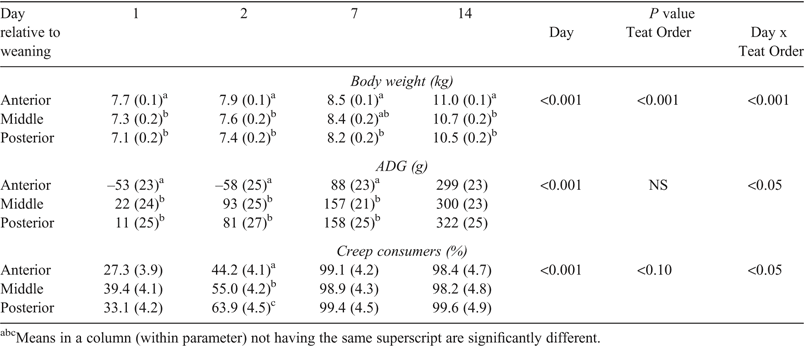Teat order influences piglet performance after weaning
D. S. Lines A , E. M. de Ruyter B , W. H. E. J. van Wettere B and K. J. Plush C DA SunPork Farms, Wasleys, SA 5400.
B The University of Adelaide, Roseworthy, SA 5371.
C South Australian Research and Development Institute, Roseworthy, SA 5371.
D Corresponding author. Email: kate.plush@sa.gov.au
Animal Production Science 55(12) 1481-1481 https://doi.org/10.1071/ANv55n12Ab078
Published: 11 November 2015
The position of piglets on the udder during sucking can influence growth rate (Pluske and Williams 1996) and the interaction between intermittent suckling and teat order has been explored previously (Berkeveld et al. 2007). However, it is not known whether a gradual reduction in sow contact has differing impacts on piglets from anterior, middle and posterior sucking positions. It was hypothesised that piglets sucking from posterior teats would show improved pre-weaning creep consumption and therefore growth after weaning, but that reduced sow contact in lactation would remove this effect of teat order.
An incremental reduction in sow contact was achieved by separating the sow from piglets (n = 30 litters) for 5 h/d (d -18 to -13 relative to weaning), 7 h/d (d -13 to -8), and 9 h/d (d -8 to -1). Control sows (n = 20) remained in full contact with the litter to weaning that occurred at 28 ± 1 d of age (mean ± SEM). Piglets were observed during sucking events to determine teat order (anterior, middle and posterior locations). Creep feed was provided from d -17, and consumers were identified (creep feed dyed using indigo carmine with piglet faeces assessed for colour using rectal swabs) and weights recorded on d -17, -12, -7, -1, 1, 2, 7 and 14 relative to weaning. Blood samples were collected on d -1 and 1 relative to weaning for plasma free cortisol concentration analysis. Non-normally distributed data were transformed prior to analysis (IBM SPSS, Version 20.0; USA) using repeated measure analysis. Creep feed intake was analysed using a binomial regression analysis with logit function (ASReml, 3rd Edition; UK).
There was no interaction between gradual weaning treatment and teat order for all traits examined (P > 0.05). Anterior positioned piglets were consistently heavier than middle and posterior piglets (Table 1; P < 0.001). Average daily gain was also influenced by teat position on the days after weaning, with posterior and middle piglets gaining more weight compared with anterior positioned piglets (P < 0.05). The number of piglets consuming creep feed was similar for all piglets across most time points except for d 2, when a reduced proportion of anterior piglets were recorded to be consuming creep than those from middle or posterior teats (P < 0.05). Plasma cortisol concentration tended to be lowest in piglets sucking posterior teats (back-transformed mean: 41.6 nmol/L) when compared with piglets sucking middle teats (55.9 mmol/L), with piglets sucking the anterior teats being intermediate (46.1 nmol/L) in response to weaning (P=0.07). Piglets from posterior teat locations had a lesser post-weaning growth check. Incremental reduction in sow contact prior to weaning did not change the performance of piglets based on their position in the teat order.

|
References
Berkeveld M, Langendijk P, van Beers-Schreurs H, Koets A, Taverner M, Verheijden J (2007) Journal of Animal Science 85, 258–266.| Crossref | GoogleScholarGoogle Scholar |
Pluske JR, Williams IH (1996) Australian Journal of Agricultural Research 47, 513–523.
| Crossref | GoogleScholarGoogle Scholar |
Supported by Pork CRC Limited Australia.


